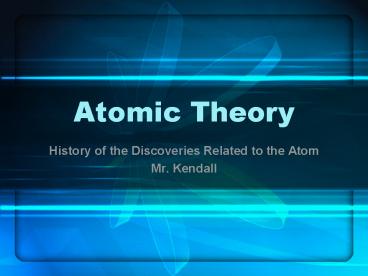Atomic Theory - PowerPoint PPT Presentation
1 / 21
Title: Atomic Theory
1
Atomic Theory
- History of the Discoveries Related to the Atom
- Mr. Kendall
2
Main Contributors To Atomic Theory
450 BC 1800 1897
1901 1910 1911 1913
Planck Quanta, predictable packets of energy
Millikan Charge on the electron of -1
Rutherford atoms have a nucleus
Bohr Proposed a model of an atom
Dalton Wrote an Atomic Theory with 4 main ideas
Thompson negative charge in the atom
Democritus Matter made of tiny things called
ATOMS
1924 1926
1926 1932 1962
Chadwick neutrons
Debroglie Matter has a wave-like nature
Heisenberg E- are waves and particles
Gell-Mann Quarks
Schrödinger E- travel in waves
3
Timeline of Atomic Theory
- 450 BC
1800s - __________________________________________________
_______
Dalton http//www.iun.edu/cpanhd/C101webnotes/c
omposition/dalton.html proposed 4 components to
an Atomic Theory.
Democritus http//www.fortbend.k12.tx.us/campuse
s/documents/Teacher/2008/teacher_20081003_1616.doc
matter was made of atoms
4
Daltons Theory Foundation of Future
Investigations
- All matter consists of tiny particles.
- Atoms are indestructible and unchangeable (Has
been modified with recent discoveries in nuclear
chemistry) - Elements are characterized by the mass of their
atoms. - When elements react, their atoms combine in
simple, whole-number ratios. Their atoms
sometimes combine in more than one simple,
whole-number ratio.
http//web.visionlearning.com/dalton_playhouse/ad_
loader.html Click the link at home to explore
more about experiments related to Daltons
theory.
5
Atomic Theory 1897-1920
- ___________________________________
Thomson http//highered.mcgraw-hill.com/sites/007
2512644/student_view0/chapter2/animations_center.h
tml negative charge in the atom 1897
Planck http//www.science.uwaterloo.ca/cchieh/ca
ct/c120/emwave.html Quanta 1901
Bohr http//www.wwnorton.com/college/chemistry/gi
lbert/tutorials/ch3.htmtop http//www.chempracti
ce.com/drills/java_Bohr.php quantum model 1913
Millikan http//highered.mcgraw-hill.com/sites/00
72512644/student_view0/chapter2/animations_center.
html charge on e- 1910
Rutherford http//www.mhhe.com/physsci/chemistry/e
ssentialchemistry/flash/ruther14.swf nucleus 1911
6
Contributions to Modern Atomic Theory
De Broglie Wave nature of matter 1924
- _____________________________________
Gell-Mann Quarks 1962
Heisenberg e- is a wave and a particle 1926
Schrodinger e- orbits as a wave 1926
Chadwick neutron 1932
7
3 Basic Parts of the Atom.
8
Types of Quarks Determine Charge
http//nobelprize.org/educational_games/physics/ma
tter/1.html
- Quarks up (2/3) and down (-1/3)
- p 2ups and 1 down
n0 2 down and 1 up - 2 2 -1 1
-1 -1 2 0 - 3 3 3
3 3 3
Gluon forces between quarks
9
Electrons travel in waves
10
Electrons are Particles / Photons
- Electrons travel in discreet packets called
photons. - To describe these unique packets or quantities of
energy the term quanta is used. - Every element on the periodic table is made up of
atoms with a unique signature of spectral lines - http//phys.educ.ksu.edu/vqm/html/emission.html
11
Predicting the Location of an Electron in an Atom
- Bohr proposed 4 characteristics to consider to
predict the location of an electron. - l the distance from the nucleus
- m the shape of the orbital in which the e-
occupies. (s,p,d,f) - n axis the orbital occupies. (x, y, z)
- s spin of the e- (1/2 , -1/2)
12
Distance from the nucleus
- Levels 1-7 When looking at the periodic table,
can be determined by the period number.
1
2
3
4
5
6
7
13
Shape of the Orbital on the x,y,z Axis
- The number of electrons in a particular region
determines the shape. - s shape 2e- p shape 6e-
14
Shape of the Orbital on the x,y,z Axis
- d shape 10e- f shape
14e-
15
Atom with overlapping orbitals
16
Spin of the Electron
- http//www.colorado.edu/physics/2000/applets/a2.ht
ml
17
Do Electrons behave as a particle or as wave?
- Definition of Light
- http//chemmovies.unl.edu/ChemAnime/DEFLITD/DEFLIT
D.html
18
Einstein vs Bohr
- Einstein causality
Bohr Predictability
If you know the initial conditions and you know
the laws of physics, you can figure out the
probability of various outcomes happening, but
you can never know which one will definitely
occur until after its over.
If you know all the initial conditions of your
system and you know the laws of physics, you can
figure out exactly whats going to happen
19
Electron behavior as it moves to other energy
levels.
- This emitted energy is equal to the difference
between the high and low energy levels, and may
be seen as light.
Light emission tutorial http//www2.wwnorton.com/c
ollege/chemistry/gilbert/tutorials/ch3.htm
20
Electrons exhibit particle and wave like
behaviorDuality
21
Particles of the Atom to date
- Nucleus
- Protons p 3 quarks
- Neutrons n0 3 quarks
- Electron Cloud
- Electrons e- (particle/wave)
Held together by a force called Gluon































